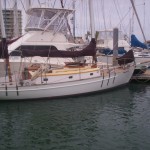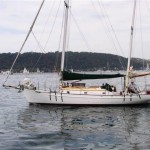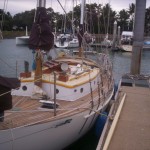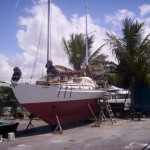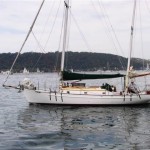Curtis NRA are a multi-disciplined, ecological and environmental consultancy, that combines the seemingly diverse disciplines of economics and science, to achieve practical outcomes in the real world. Some examples of recent outcomes appear below. Contact Dr Ian Curtis by phone at 0434 881 694, or email: ian@curtisnra.com.au
Author Archives: Ian
Classic 35′ LOA Herreshoff Cutter Ketch for sale!!!
Custom built in Seattle, USA in 1984, this yacht has been built by a master craftsman. Hand laid 25mm thick fibreglass hull, timber decks and superstructure, cabin, cockpit etc. All deck fittings are custom bronze (impossible for an Oz built boat). Two new bronze Harken 2 speed self tailing sheet winches. Interior fully lined with fore & aft timber planks, and finely fitted cabinetry. 4 berth, saloon, galley & heads. Completely refitted and rerigged with oversize 7/19 SS wire rigging in 2008. All new covers, boom bag, dodger, sail bags etc. 15hp Yanmar diesel, new 2005.
Equipment includes: wind vane and self-steering mechanism; auto-pilot (12V); GPS; 27mhz radio; portable depth sounder/fish finder; etc
This yacht sailed on it’s own bottom to Hawaii from mainland USA, and thence undertook three return trips to New Zealand, thence to Tonga, logging some 20,000nm in the Pacific, and thence to Brisbane from Tonga, where she was imported in 1990. Now NSW registration.
FIRST ENTHUSIAST TO SEE WILL BUY! Price $49,500 ONO
Recent Survey available:
Phone Dr Ian Curtis on 0429 469081, or email ian@curtisnra.com.au
In court with the Sekusu Sisapi people
65 villagers travelled from the Gulf Province to Port Moresby to get justice for the illegal logging of their forests by Rimbunan Hijau, and I sat with them in the back of the Supreme Court. Seeing as they were probably sleeping rough, and wearing the same clothes every day in this tropical climate, the atmosphere was pretty ripe! Alas, the matter was adjourned:
Now until February 2014, meaning that the landowners have not had a reasonable hearing and either will have to wait it out on the streets of Port Moresby, or somehow find a way to get back to their families in the Gulf Province. So much for the justice system in PNG.
Wondering what ecosystem goods and services are?
Curtis NRA, recently advising on the loss of their natural environment in two instances of illegal logging in Papua New Guinea (see previous posts), used this description, attributed to Tim Anderson USyd 2006: “Access to materials for food; housing; materials for medicine; fuels; fences; weapons; tools; canoes; textiles; string bags (bilums); cords and rope; musical instruments; artworks; and, articles of personal adornment, ritual and magic”.
This makes sense when you consider that the customary landowners in Papua New Guinea, particularly those remote from a major town like Lae, Madang or Port Moresby, do not have access to a trading venue (market), for their goods. Nor is there a social security system in PNG.
SO! The ecosystem goods and services above are all that they have for survival.
Rod Campbell from Melbourne-based ‘Economists at Large’ points out that the above definition only includes ‘goods’ and NO ‘services’, such as climate regulation, water regulation etc., And, he is right, however Anderson may have concluded that the customary landowners took these for granted.
Curtis NRA adopts the now commonly accepted list of 20 goods and services, modified and complemented after Costanza 1997.
Illegal loggers, Rimbunan Hijau, at it again!!
Gaden’s Lawyers Port Moresby have just engaged Curtis NRA to assess the environmental damage, and to quantify the economic loss of resources owned by the customary landowners around Kikori, in the Gulf and Southern Highland provinces, due to sustained illegal logging by Malaysian Giant, Rimbunan Hijau (RH). Corruption and bribery was also high on the agenda, as the PNG Constabulary were used to suppress the customary landowner’s objections to the ilegal logging of their land, resulting in many injuries to young men and boys. Keep watching for more updates on this matter. Damage is estimated to be in the vicinity of PNG Kina 70 million.
A hearing before the National Court of Papua New Guinea is pending. Clearly the Kiunga-Aimbak judgement in the Western Province will be used as a legal precedent.
Federal Environment Minister, Tony Burke, fails to protect the environment!
Tony Burke has approved the Maules Creek Open Cut Coal mine, which will result in the loss of about 5000ha of Grassy Box Woodland in Leard State Forest, and the Koala habitat. THIS IS A NET LOSS of this community, DESPITE the required offsets! Just have a look at the description of this community included in the NSW listing of the community as critically endangered:
When is an environmental offset not an environmental offset?
When they are not commensurate!
The author sat in on a meeting with Boggabri Coal in 2011, and heard that the offsets required by the NSW Govt for the clearing of critically endangered Grassy Box Woodland (GBW) in Leard Forest had been set at six times the area impacted by the mine, however, the offsets acquired (and approved) were ‘derived grasslands’ ie. where the GBW had been completely cleared (leaving only grassland with a seedbank in the soil). All physical scientists know that eucalypts will not regenerate without intervention, such as fire (heat); smoke; sclarifying (scraping the seed with a knife). So there is little or no chance of natural regeneration on the derived grasslands.
Now Ecologist Phil Sparks has drawn this conclusion from his investigation of other offsets put in place by Boggabri Coal. Continue reading
The ACF’s ‘Brave New World’
The Australian Conservation Foundation has finally adopted what a lot of us have known all along. That being, the environment is NOT a ‘free good’. Recognising this, leads to an appreciation that we need to know precisely what it is worth in money terms. As money value is the primary motivating factor in land-use decisions, it must be shown that to knock down native vegetation comes at a price.
The ACF put it this way:
“Valuing the environment is not an idealist goal, it’s a crucial factor in much of the decision-making affecting our environment. That’s why we’ve launched the New Economics Advisory Service, a specialist crew of economists who can provide economic assessments for your environmental project”.
CurtisNRA are one of the leaders in the field of environmental valuation, and are connected with this initiative through their association with one of the advisory panel members, Economists at Large (see previous post where CurtisNRA collaborated with Eco-large to value the ecological goods and services provided by the travelling stock routes in NSW).
Environmental Offsets: Have we got the science right?
For any offset to mitigate against adverse impacts of a proposal or project (in the context of EIS practice), it must FIRST be seen to be commensurate. In other words, does the offset practically replicate the landscape, fauna and floral assemblages, and density of population, as well as the application of a multiplier to ensure there is no net loss of that population.
Secondly, and of equal importance, is a guarantee that the offset be of equivalent economic value of the natural system at risk, which takes into account location (distance from markets), human population density; extent of services; property values, and economic conditions at the time of valuation.
Accordingly, economic valuation of the impact of a proposal or policy, as well as the proposed OFFSETS, MUST be mandatory for any offset strategy!
Professor Bennett and Rob Gillespie LOST in their paradigms??
In a recent Land and Environment hearing in regard to a Rio Tinto subsidiary’s plans to extend the Warkworth Coal Project into areas of native vegetation in the Hunter Valley, including areas of threatened Warkworth Sands Woodland. Professor Jeff Bennett and Mr Rob Gillespie for the applicants stated that the methodology used by Curtis NRA to value native vegetation “has no basis in Welfare Economics and is therefore incompatible with Benefit Cost Analysis”.
Clearly they did not think it through, Continue reading

